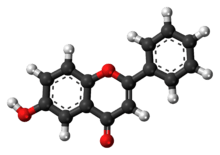6-Hydroxyflavone
 | |
 | |
| Names | |
|---|---|
| IUPAC name
6-hydroxy-2-phenylchromen-4-one | |
| Other names
6-Monohydroxyflavone; 6-Hydroxy-2-phenyl-4-benzopyrone | |
| Identifiers | |
| 6665-83-4 | |
| 3D model (Jmol) | Interactive image Interactive image |
| ChEMBL | ChEMBL138649 |
| ChemSpider | 65233 |
| ECHA InfoCard | 100.027.005 |
| EC Number | 229-704-8 |
| KEGG | C14137 |
| PubChem | 72279 |
| |
| |
| Properties | |
| C15H10O3 | |
| Molar mass | 238.24 g·mol−1 |
| Melting point | 234 to 236 °C (453 to 457 °F; 507 to 509 K) |
| Except where otherwise noted, data are given for materials in their standard state (at 25 °C [77 °F], 100 kPa). | |
| | |
| Infobox references | |
6-Hydroxyflavone is a flavone, a type of chemical compound. It is one of the noncompetitive inhibitors of cytochrome P450 2C9. It is reported in leaves of Barleria prionitis Linn. (a common Acanthaceae from India).[1] 6-Hydroxyflavone may have a potential as a therapeutic drug capable for the treatment of anxiety-like disorders.[2]
References
- ↑ Medicinal plants, Chemistry and properties by M Daniel.
- ↑ "GABAA receptor subtype selectivity underlying anxiolytic effect of 6-hydroxyflavone". ScienceDirect. Retrieved 2011-06-12.
External links
This article is issued from Wikipedia - version of the 10/10/2016. The text is available under the Creative Commons Attribution/Share Alike but additional terms may apply for the media files.